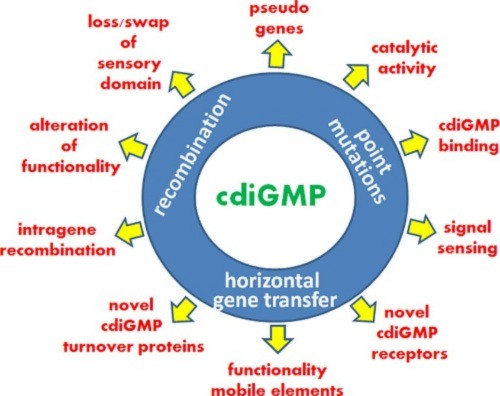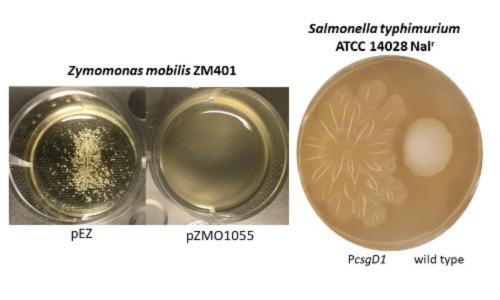Panta rhei
Posted on July 13, 2023 by Ute Römling, PhD, Professor of Medical Microbial Physiology and Lianying Cao, PhD, Fengwu Bai, PhD, Distinguished Professor
Professor Römling and Professor Cao take us behind the scenes of their latest publication ‘Evolution of cyclic di-GMP signalling on a short and long term time scale’ published in Microbiology.
For the review ‘Evolution of cyclic di-GMP signalling on a short and long term time scale’ we teamed up: Lian-Ying Cao, PhD and Distinguished Professor Fengwu Bai at Shanghai Jiao Tong University, China and Ute Römling, Professor of Medical Microbial Physiology at the Karolinska Institutet in Stockholm, Sweden.

Both of our research groups have a genuine interest in signalling by the second messenger cyclic di-GMP and biosynthesis of the cyclic di-GMP dependent biofilm extracellular matrix component cellulose. Our interest however arises from different research directions; studying the behaviour of the gastrointestinal pathogen Salmonella typhimurium and flocculation in the biotechnology relevant ethanol producing Gram-negative bacterium Zymomonas mobilis.
The RNA molecule cyclic di-GMP has been recognized as a ubiquitous second messenger molecule in bacteria, positively promoting biofilm formation. Our initial interest was in the regulation of a peculiar colony morphology in the gamma-proteobacterium S. typhimurium on agar plates, termed the rdar (red, dry and rough) morphotype, and in the molecular mechanisms of induction of flocculation in the alpha-proteobacterium Z. mobilis. However, our results indicated that cyclic di-GMP signalling directing cellulose biosynthesis is intimately coupled to the emergence of these different types of multicellular assemblies in the phylogenetically distinct autonomous bacterial cells.
In this context, we identified different mechanisms for the emergence of (semi)-constitutive multicellular behavior in the two bacterial organisms.

Multicellular behavior of Zymomonas mobilis and Salmonella typhimurium
Flocs of the variant Zymomonas mobilis ZM401 are dissolved upon overexpression of the phosphodiesterase ZMO1055 (left).
Salmonella typhimurium ATCC 14028 Nalr with promoter mutant PcsgD1 (insertion of adenosine at position -17 of the csgD promoter) and wild type promoter (right panel).
In S. typhimurium, a single nucleotide insertion or a transversion in the promoter region of the major biofilm regulatory gene csgD converted the organism to semi-constitutively assemble into tissue-like structures. Among the molecular mechanisms for this behaviour was the transcriptional activation of the diguanylate cyclase gene adrA required for cellulose biosynthesis.
In Z. mobilis, a single nucleotide deletion and a transition led to a fused cellulose synthase and a phosphodiesterase with significantly diminished activity, respectively. The A526V substitution of the phosphodiesterase ZMO_1055 occurred outside of conserved signature amino acids required for catalytic activity. We considered the impact of this conservative amino acid replacement sufficiently relevant to contemplate the variability of the cyclic di-GMP signaling system. Thus, we decided to summarize the different modes of variability that had been observed in the context of the cyclic di-GMP signaling network in our review.
Thus, our review deals with the immediate and evolutionary established variability of cyclic di-GMP network components, enzymes involved in the synthesis and degradation equally as cyclic di-GMP receptors. This variability is manifested by diverse well-established modes of creation of genetic variability and includes single nucleotide polymorphisms leading to amino acid substitutions, recombination, and horizontal gene transfer. Of particular interest and importance from an evolutionary perspective is the rapid disappearance of the cyclic di-GMP signaling system. Having summarized these mechanisms will allow the reader not only to get an overview of the flexibility and adaptability of this second messenger signaling system, but also to realize open questions in this highly actual research area.
Cyclic di-GMP signaling is relevant in bacterial species throughout their phylogenetic tree regulating multicellular assembly including biofilm formation and flocculation, motility, virulence and chronic infection. Those fundamental physiological, metabolic and behavioural traits occur in environmental organisms as well as pathogens extended to bacterial-bacterial interactions equally as interkingdom interactions with archaea and eukaryotes. The relevance of those traits spans from ecological importance in all ecosystems and agriculture over human and animal health and disease to industrially relevant applications. Although a lot has already been discovered with respect to cyclic di-GMP signaling, there are certainly still aspects of fundamental importance that have remained unexplored.
References
Cao LY, Yang YF, Zhang X, Chen YH, Yao JW, Wang X, Xia J, Liu CG, Yang SH, Römling U, Bai FW. Deciphering Molecular Mechanism Underlying Self-Flocculation of Zymomonas mobilis for Robust Production. Appl Environ Microbiol. 2022, 88:e0239821.
Liu Y, Lee C, Li F, Trček J, Bähre H, Guo RT, Chen CC, Chernobrovkin A, Zubarev R, Römling U. A Cyclic di-GMP Network Is Present in Gram-Positive Streptococcus and Gram-Negative Proteus Species. ACS Infect Dis. 2020, 6:2672-2.
El Mouali Y, Kim H, Ahmad I, Brauner A, Liu Y, Skurnik M, Galperin MY, Römling U. Stand-Alone EAL Domain Proteins Form a Distinct Subclass of EAL Proteins Involved in Regulation of Cell Motility and Biofilm Formation in Enterobacteria. J Bacteriol. 2017 Aug 22;199(18):e00179-17.
Römling U, Sierralta WD, Eriksson K, Normark S. Multicellular and aggregative behaviour of Salmonella typhimurium strains is controlled by mutations in the agfD promoter. Mol Microbiol. 1998, 28:249-64.

